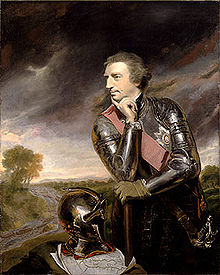
Back Jeffery Amherst AN جيفري أمهيرست Arabic جيفرى امهيرست ARZ Джефри Амхърст Bulgarian Jeffrey Amherst Catalan Jeffrey Amherst, 1. Baron Amherst German Jeffrey Amherst Spanish جفری آمهرست Persian Jeffery Amherst Finnish Jeffery Amherst French
The Lord Amherst | |
|---|---|
 Portrait by Joshua Reynolds | |
| Commander-in-Chief, North America | |
| In office 1758–1763 | |
| Crown Governor of Virginia | |
| In office 1759–1768 | |
| Monarchs | |
| Preceded by | The Earl of Loudoun |
| Succeeded by | The Lord Botetourt |
| Governor of the Province of Quebec | |
| In office 1760–1763 | |
| Monarch | George III |
| Preceded by | Post created, replacing the French post of Governor General of New France |
| Succeeded by | James Murray |
| Personal details | |
| Born | 29 January 1717 Sevenoaks, Kent, England |
| Died | 3 August 1797 (aged 80) Sevenoaks, Kent, England |
| Resting place | Parish Church, Sevenoaks |
| Awards | Order of the Bath |
| Signature |  |
| Military service | |
| Allegiance | Kingdom of Great Britain |
| Branch/service | British Army |
| Years of service | 1735–1795 |
| Rank | Field marshal |
| Commands | |
| Battles/wars | |
Field Marshal Jeffery[n 1] Amherst, 1st Baron Amherst, KB (29 January 1717 – 3 August 1797) was a British Army officer and Commander-in-Chief of the Forces in the British Army. Amherst is credited as the architect of Britain's successful campaign to conquer the territory of New France during the Seven Years' War. Under his command, British forces captured the cities of Louisbourg, Quebec City and Montreal, as well as several major fortresses. He was also the first British governor general in the territories that eventually became Canada. Numerous places and streets are named after him, in both Canada and the United States.
Amherst's legacy is controversial due to his expressed desire to spread smallpox among the disaffected tribes of Indians during Pontiac's War. This has led to a reconsideration of his legacy. In 2019, the city of Montreal removed his name from a street, renaming it Rue Atateken, from the Kanien'kéha Mohawk language.[1]
Cite error: There are <ref group=n> tags on this page, but the references will not show without a {{reflist|group=n}} template (see the help page).